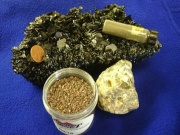Difference between revisions of "Abrasive"
| Line 2: | Line 2: | ||
== Description == | == Description == | ||
| − | Hard, fine particles used to polish metals, stone, wood, glass, and other materials. Naturally occurring materials used as abrasives include [ | + | Hard, fine particles used to polish metals, stone, wood, glass, and other materials. Naturally occurring materials used as abrasives include [[diamond|diamond]], [[emery|emery]], [[corundum|corundum]], [[sand|sand]], [[garnetgarnet], [http://cameo.mfa.org/materials/fullrecord.asp?name=quartz quartz], [http://cameo.mfa.org/materials/fullrecord.asp?name=pumice pumice], [http://cameo.mfa.org/materials/fullrecord.asp?name=diatomaceous%20earth diatomite], [http://cameo.mfa.org/materials/fullrecord.asp?name=kaolin kaolin], [http://cameo.mfa.org/materials/fullrecord.asp?name=fuller%27s%20earth fuller's earth], [http://cameo.mfa.org/materials/fullrecord.asp?name=talc talc], [http://cameo.mfa.org/materials/fullrecord.asp?name=chalk chalk], and [http://cameo.mfa.org/materials/fullrecord.asp?name=cuttlebone cuttlefish bone]. Manufactured materials used as abrasives include [http://cameo.mfa.org/materials/fullrecord.asp?name=silicon%20carbide silicon carbide], [http://cameo.mfa.org/materials/fullrecord.asp?name=aluminum%20oxide aluminum oxide], [http://cameo.mfa.org/materials/fullrecord.asp?name=zirconium%20oxide zirconium oxide], [http://cameo.mfa.org/materials/fullrecord.asp?name=titanium%20dioxide titanium dioxide], green rouge ([http://cameo.mfa.org/materials/fullrecord.asp?name=chromic%20oxide chromic oxide]), [http://cameo.mfa.org/materials/fullrecord.asp?name=stannic%20oxide stannic oxide], [http://cameo.mfa.org/materials/fullrecord.asp?name=ceric%20oxide cerium oxide], [http://cameo.mfa.org/materials/fullrecord.asp?name=glass glass], [http://cameo.mfa.org/materials/fullrecord.asp?name=boron%20carbide boron carbide], [http://cameo.mfa.org/materials/fullrecord.asp?name=boron%20nitride boron nitride], and [http://cameo.mfa.org/materials/fullrecord.asp?name=synthetic%20diamond synthetic diamond]. Abrasives are sold as powders, slurries, and as abrasive cloths, papers, and wheels. They are characterized by hardness and particle size. Their hardness can be measured on the [http://cameo.mfa.org/materials/fullrecord.asp?name=Mohs%27%20hardness%20scale Mohs' scale] in which the diamond is rated as a 10. Mild abrasives, such as chalk and talc, have a hardness of 1-3 Mohs. Diamond and silicon carbide are hard abrasives. Particle size depends on the mesh of the sieves used for separation, i.e. a 600 grit abrasive contains particles 8 micrometers and smaller. |
== Synonyms and Related Terms == | == Synonyms and Related Terms == | ||
Revision as of 12:06, 6 January 2014
Description
Hard, fine particles used to polish metals, stone, wood, glass, and other materials. Naturally occurring materials used as abrasives include Diamond, Emery, Corundum, Sand, [[garnetgarnet], quartz, pumice, diatomite, kaolin, fuller's earth, talc, chalk, and cuttlefish bone. Manufactured materials used as abrasives include silicon carbide, aluminum oxide, zirconium oxide, titanium dioxide, green rouge (chromic oxide), stannic oxide, cerium oxide, glass, boron carbide, boron nitride, and synthetic diamond. Abrasives are sold as powders, slurries, and as abrasive cloths, papers, and wheels. They are characterized by hardness and particle size. Their hardness can be measured on the Mohs' scale in which the diamond is rated as a 10. Mild abrasives, such as chalk and talc, have a hardness of 1-3 Mohs. Diamond and silicon carbide are hard abrasives. Particle size depends on the mesh of the sieves used for separation, i.e. a 600 grit abrasive contains particles 8 micrometers and smaller.
Synonyms and Related Terms
diamond; emery; corundum; sand; garnet; quartz; pumice; diatomite; kaolin; fuller's earth; talc; chalk; cuttlefish bone; silicon carbide; aluminum oxide; zirconium oxide; titanium dioxide; green rouge; chromic oxide; tin oxide; cerium oxide; glass; boron carbide; boron nitride; steel wool; abrasive paper; lubrisil, micromesh; abrasive powder; crocus powder; jewelers rouge; rottenstone; tripoli powder; whiting; Schleifmittel (Deut.); abrasif (Fr.);
Comparisons
Properties of Common Abrasives
Properties of Common Abrasives
Authority
- Encyclopedia Britannica, http://www.britannica.com Comment: "abrasive" Encyclopædia Britannica. [Accessed October 2, 2003].
- G.S.Brady, Materials Handbook, McGraw-Hill Book Co., New York, 1971 Comment: p. 4
- Matt Roberts, Don Etherington, Bookbinding and the Conservation of Books: a Dictionary of Descriptive Terminology, U.S. Government Printing Office, Washington DC, 1982
- Robert Fournier, Illustrated Dictionary of Practical Pottery, Chilton Book Company, Radnor, PA, 1992
- Random House, Webster's Encyclopedic Unabridged Dictionary of the English Language, Grammercy Book, New York, 1997
- The American Heritage Dictionary or Encarta, via Microsoft Bookshelf 98, Microsoft Corp., 1998
- Wikipedia, the free encyclopedia, at http://www.wikipedia.com Comment: http://en.wikipedia.org/wiki/Abrasive (Accessed Jan. 15, 2006)
- Hermann Kuhn, Conservation and Restoration of Works of Art and Antiquities, Butterworths, London, 1986
- Tom Rowland, Noel Riley, A-Z Guide to Cleaning, Conserving and Repairing Antiques, Constable and Co., Ltd., London, 1981
- Art and Architecture Thesaurus Online, http://www.getty.edu/research/tools/vocabulary/aat/, J. Paul Getty Trust, Los Angeles, 2000
